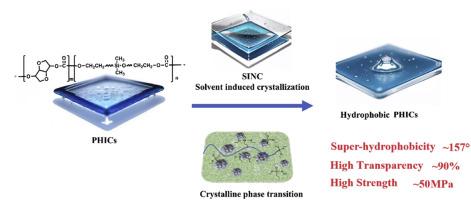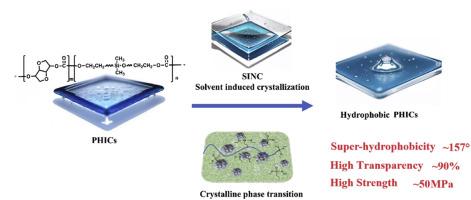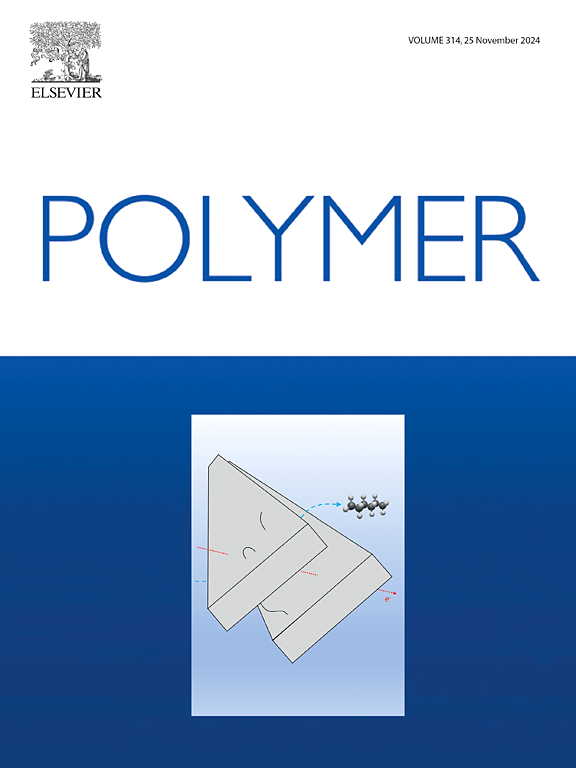Facile fabrication of hemicrystalline bio-based polycarbonate with superhydrophobic and high transmittance
IF 4.1
2区 化学
Q2 POLYMER SCIENCE
引用次数: 0
Abstract
Developing materials that combine superhydrophobic properties with high optical transmittance poses a significant challenge. In this study, hydroxyl-terminated polydimethylsiloxane (HT-PDMS) and isosorbide (ISB) were polymerized in a single step to create a covalently bonded optical polycarbonate material. By inducing the formation of micro-papillary and lotus-shaped nanoscale structures via a solvent-triggered process, we significantly enhanced the “air cushion” effect, achieving a structure scale of approximately 5–7 μm. This resulted in a water contact angle of 157° while maintaining over 90 % optical transmittance. The structures were uniformly distributed throughout the polymer matrix, leading to a 500 % increase in tensile strength at break compared to pure isosorbide polycarbonate, with a maximum strength exceeding 50 MPa. These multifunctional materials show great promise for applications in smart windows, solar panels, camera lenses, and other optoelectronic devices.


轻松制备具有超疏水和高透光率的半结晶生物基聚碳酸酯
开发兼具超疏水特性和高透光率的材料是一项重大挑战。在这项研究中,羟基封端聚二甲基硅氧烷(HT-PDMS)和异山梨醇(ISB)通过一步聚合生成了共价键合的光学聚碳酸酯材料。通过溶剂触发工艺诱导形成微毛细管和莲花状纳米结构,我们显著增强了 "气垫 "效应,实现了约 5-7 μm 的结构尺度。这使得水接触角达到 157°,同时保持了 90% 以上的透光率。这些结构均匀地分布在整个聚合物基体中,与纯异山梨醇聚碳酸酯相比,断裂拉伸强度提高了 500%,最大强度超过 50 兆帕。这些多功能材料在智能窗户、太阳能电池板、相机镜头和其他光电设备中的应用前景广阔。
本文章由计算机程序翻译,如有差异,请以英文原文为准。
求助全文
约1分钟内获得全文
求助全文
来源期刊

Polymer
化学-高分子科学
CiteScore
7.90
自引率
8.70%
发文量
959
审稿时长
32 days
期刊介绍:
Polymer is an interdisciplinary journal dedicated to publishing innovative and significant advances in Polymer Physics, Chemistry and Technology. We welcome submissions on polymer hybrids, nanocomposites, characterisation and self-assembly. Polymer also publishes work on the technological application of polymers in energy and optoelectronics.
The main scope is covered but not limited to the following core areas:
Polymer Materials
Nanocomposites and hybrid nanomaterials
Polymer blends, films, fibres, networks and porous materials
Physical Characterization
Characterisation, modelling and simulation* of molecular and materials properties in bulk, solution, and thin films
Polymer Engineering
Advanced multiscale processing methods
Polymer Synthesis, Modification and Self-assembly
Including designer polymer architectures, mechanisms and kinetics, and supramolecular polymerization
Technological Applications
Polymers for energy generation and storage
Polymer membranes for separation technology
Polymers for opto- and microelectronics.
文献相关原料
公司名称
产品信息
阿拉丁
isosorbide
阿拉丁
Diphenyl carbonate
 求助内容:
求助内容: 应助结果提醒方式:
应助结果提醒方式:


